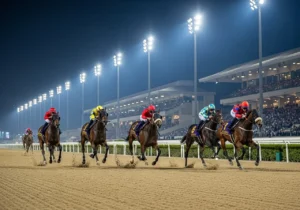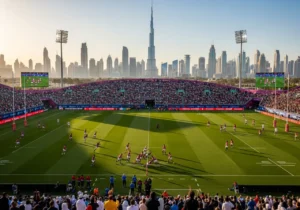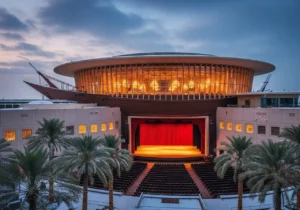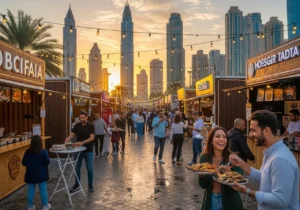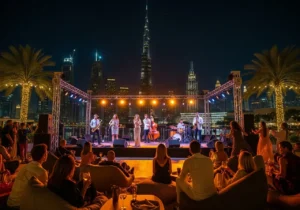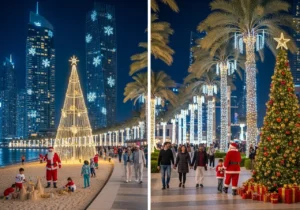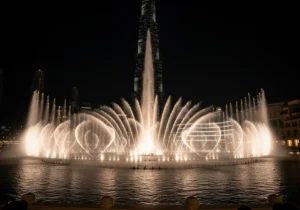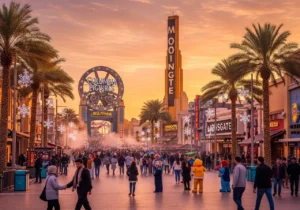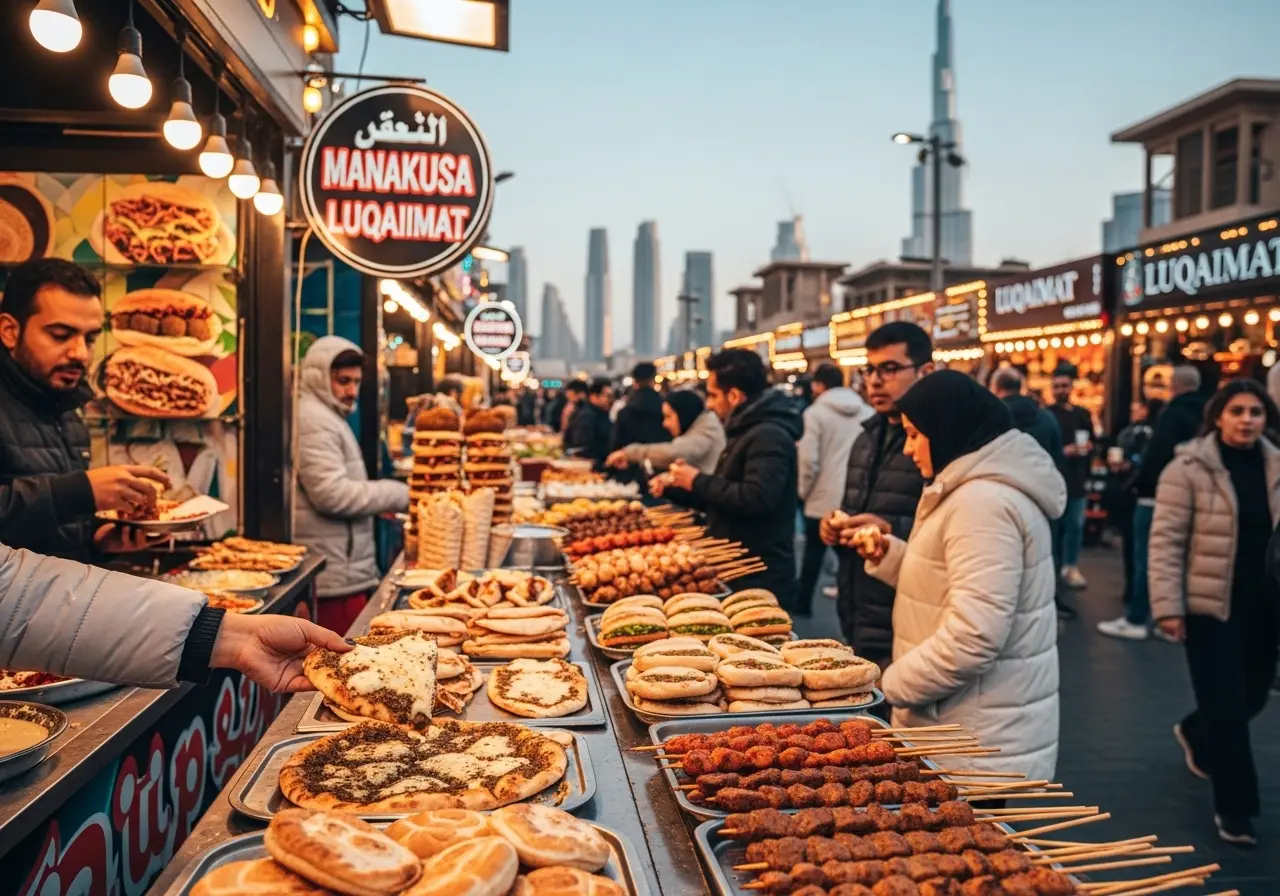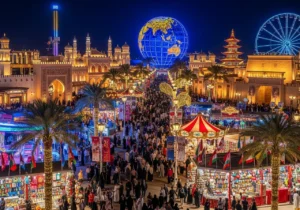Street Food in Dubai: A Flavorful Journey Through the City’s Soul
To truly understand the heart of a city, you must taste its streets. Beyond the Michelin-starred restaurants and lavish brunches, the vibrant, multicultural soul of Dubai is best discovered in its bustling alleyways and humble cafeterias. This is the world of street food in Dubai, a thrilling culinary adventure that tells the story of the city’s diverse heritage.
The arrival of the cool, pleasant winter season marks the perfect time to embark on this gastronomic exploration. The comfortable evenings are ideal for strolling through historic neighborhoods, guided by the irresistible aromas of spices, grilling meats, and freshly baked bread. This is when the culture of street food in Dubai truly comes alive.
This guide is your passport to the most authentic and delicious flavors the city has to offer. We will journey through the must-try dishes, explore the legendary food neighborhoods, and uncover the secrets of the best street food in Dubai.
Why Winter is the Ultimate Season for Street Food in Dubai
While the city’s culinary scene is a year-round affair, winter is undeniably the peak season for exploring street food in Dubai. The beautiful weather, with its mild temperatures and cool breezes, transforms the entire city into a comfortable al fresco dining destination.
This is the time when outdoor food markets flourish. Major attractions like Global Village open their gates, offering a world of street food in one place. Community markets like the Ripe Market are in full swing, and beachside promenades are lined with pop-up eateries and food trucks.
The comfortable climate makes a walking food tour not just possible, but incredibly enjoyable. You can wander for hours through neighborhoods like Bur Dubai and Deira, sampling different delicacies without the oppressive heat of the summer. The entire experience of discovering street food in Dubai is elevated during the winter months.
The Classics: Must-Try Emirati and Middle Eastern Street Food Dishes
The foundation of street food in Dubai is built on the rich and comforting flavors of Emirati and Middle Eastern cuisine. These are the timeless classics that have been enjoyed by locals for generations.
Shawarma: The Undisputed King
No discussion of street food in Dubai can begin without paying homage to the shawarma. This iconic wrap is a masterpiece of flavors and textures. Layers of marinated chicken or lamb are stacked on a vertical rotisserie and slow-roasted for hours.
The succulent meat is then shaved off, placed in a warm Arabic flatbread (khubz), and topped with garlic paste (toum), tahini sauce, pickles, and french fries. The best shawarma in Dubai is a hotly debated topic, with legendary spots in Satwa and Deira having fiercely loyal followings.
Samboosa (Samosa): The Perfect Crispy Snack
Samboosas are the perfect on-the-go snack. These are small, crispy, deep-fried pastries filled with a variety of savory ingredients. The most common fillings are spiced minced meat, vegetables, or a simple but delicious salty cheese. You will find small cafeterias selling these hot and fresh throughout the day, a staple of street food in Dubai.
Luqaimat: Sweet and Syrupy Dumplings
For those with a sweet tooth, Luqaimat are an essential Emirati treat. These are small, golden, deep-fried dumplings that are crispy on the outside and soft and airy on the inside.
After being fried, they are generously drizzled with date syrup (dibs) and sometimes sprinkled with sesame seeds. The name translates to “small bites,” and it is impossible to have just one. The traditional Luqaimat recipe is a cherished part of the local culinary heritage and a highlight of Emirati street food.
Regag Bread and Chebab Pancakes
These two traditional breads are often prepared live at cultural festivals and heritage sites, but you can also find them in traditional neighborhoods. Regag is a very thin, crispy bread, almost like a cracker, that is cooked on a hot plate. It is often topped with egg, cheese, or the sweet fish sauce known as mahyawa.
Chebab are the Emirati version of pancakes. They are infused with the warm flavors of cardamom, saffron, and turmeric, giving them a beautiful yellow hue. They are typically served drizzled with date syrup, making for a delicious breakfast or dessert.
Falafel and Hummus: Timeless Staples
While found throughout the Levant, falafel has been wholeheartedly adopted into the fabric of street food in Dubai. These deep-fried balls or patties made from ground chickpeas or fava beans are a vegetarian delight.
A classic falafel sandwich is served in a pita bread, stuffed with hummus, tahini, salad, and pickles. It is a simple, affordable, and incredibly satisfying meal that you can find at countless cafeterias across the city.
Karak Chai: The Unofficial National Drink
You cannot truly experience street food in Dubai without trying Karak chai. This strong, sweet, and milky tea is infused with cardamom and other spices, creating a wonderfully aromatic and comforting beverage.
Hundreds of roadside cafeterias and tea stalls serve this beloved drink, often for just one or two dirhams. The ritual of pulling up to a cafeteria, honking your horn, and having a steaming cup of karak delivered to your car is a quintessential Dubai experience.
A World on a Plate: International Street Food in Dubai
Dubai’s identity as a global crossroads is most deliciously expressed through its international street food scene. The city’s large expatriate communities have brought the authentic flavors of their home countries to the streets of Dubai.
The Flavors of India and Pakistan in Bur Dubai
The neighborhood of Bur Dubai, particularly the area known as Meena Bazaar, is a vibrant hub of South Asian culture and cuisine. A Bur Dubai food tour is an assault on the senses in the best possible way.
- Pani Puri and Chaat: Chaat is a category of savory Indian snacks. Pani Puri consists of a small, hollow, crispy ball (puri) that is filled with a mixture of potatoes, chickpeas, and spices, and then dunked in a tangy, flavored water (pani). It is an explosion of flavor in one bite.
- Vada Pav: Often called the “Bombay Burger,” this is a popular snack from Mumbai. It consists of a deep-fried potato dumpling placed inside a soft bread bun, served with various chutneys.
- Kebabs and Tikkas: The streets of Meena Bazaar and the surrounding areas are filled with the smoke and aroma of grilling kebabs. Legendary cafeterias like Al Ustad Special Kabab serve tender, marinated lamb and chicken kebabs that have been famous for decades. This is a highlight of international street food in Dubai.
A Taste of the Philippines in Karama and Deira
The vibrant Filipino community has made its culinary mark on Dubai, especially in neighborhoods like Karama and Satwa. Here, you can find authentic and affordable Filipino barbecue.
Street food stalls, particularly on weekends, grill skewers of chicken, beef, and more adventurous options like ‘Isaw’ (chicken intestines), which are a beloved delicacy. It is a fantastic opportunity to experience the fun and flavorful culture of Filipino street food.
Levantine Delights: Manakish and Knafeh
Manakish is a popular Levantine flatbread that is often described as an “Arabic pizza.” It is typically topped with za’atar (a thyme and sesame seed mix), cheese (akkawi), or minced meat. It is a delicious and cheap breakfast or lunch, baked fresh in traditional ovens.
For dessert, Knafeh is a must-try. This beloved Middle Eastern sweet is made with a layer of spun pastry or semolina, a rich cheese filling, and soaked in a sweet, sugar-based syrup. It is often sold at street-side windows, served hot and gooey.
The Best Neighborhoods for a Street Food Tour
To find the best street food in Dubai, you need to head to the city’s older, more historic, and culturally diverse neighborhoods.
Deira: The Old Trading Hub
Deira is one of the oldest parts of Dubai and remains a bustling commercial center. The streets around the Gold Souk, Spice Souk, and Naif are packed with traditional cafeterias, juice stalls, and bakeries. This is a fantastic area to find authentic shawarma, fresh fruit juices, and a wide variety of Middle Eastern and South Asian snacks. The Deira street food scene is a glimpse into the city’s past.
Bur Dubai and Meena Bazaar: Little India
Across the creek from Deira lies Bur Dubai, and its heart is Meena Bazaar. This area is a vibrant, bustling hub that feels like it has been teleported directly from India. The streets are lined with an incredible density of restaurants and stalls selling every imaginable type of Indian street food in Dubai, with a particular focus on vegetarian delicacies.
Satwa and Al Dhiyafah Street: A Culinary Crossroads
2nd of December Street, formerly known as Al Dhiyafah Street, is a legendary food destination. This long road in the neighborhood of Satwa is a melting pot of cuisines. Here, you will find some of the city’s most famous and beloved eateries, from Lebanese bakeries to Iranian kebab houses and iconic Filipino and Indian restaurants. A walk down this street is a culinary journey in itself and a key part of any Satwa food guide.
Karama: A Hidden Gem
Karama is a bustling, largely residential neighborhood that is famous among foodies for its incredible array of affordable and authentic restaurants. It is particularly known for its fantastic South Indian cuisine, with many restaurants serving delicious dosas, thalis, and biryanis for just a few dirhams. It is one of the best areas for where to eat cheap in Dubai.
Practical Guide to Your Dubai Street Food Adventure
Embarking on a street food tour is easy and rewarding. Here are a few tips to get you started.
Finding the Best and What to Expect
For a culinary experience of a different kind, you can enjoy a traditional Emirati dinner under the stars at a desert camp. For luxurious and authentic desert safari dinner packages, you can explore the options at https://royaldesertadventures.ae/. For other city and food tour packages, you can browse offerings at https://dubaidesertsafarie.com/ or https://hafiztourism.com/.
Conclusion: A True Taste of the City
The world of street food in Dubai is a vibrant, diverse, and delicious reflection of the city itself. It is a culinary landscape built by immigrants, rooted in tradition, and bursting with authentic flavors.
To truly experience Dubai, you must step away from the fine-dining restaurants and immerse yourself in the bustling energy of its food streets. A winter evening spent hopping between cafeterias, sipping on karak chai, and indulging in a perfectly made shawarma is one of the most authentic and memorable experiences the city has to offer. This is the real taste of Dubai.
Frequently Asked Questions (FAQs)
1. Is it safe to eat street food in Dubai? Yes, it is very safe. Dubai has very strict food safety regulations that are enforced by the Dubai Municipality. Restaurants and cafeterias, no matter how small, are regularly inspected to ensure they meet high standards of hygiene and cleanliness.
2. What is the average cost of street food in Dubai? Street food in Dubai is incredibly affordable. You can get a delicious shawarma wrap or falafel sandwich for around AED 5-10 ($1.50 – $3.00). A cup of Karak chai is often just AED 1. You can have a full, satisfying meal for a very small amount of money.
3. What is the most famous street food dish in Dubai? The most famous and iconic street food dish is undoubtedly the shawarma. It is a beloved staple and a must-try for any visitor looking to experience the authentic taste of street food in Dubai.
4. Which neighborhoods are best for a street food tour? The best neighborhoods are the older, more traditional parts of the city. These include Bur Dubai (especially Meena Bazaar), Deira (around the souks), Satwa (specifically 2nd of December Street), and Karama.
5. What is Karak Chai? Karak chai Dubai is famous for is a strong, sweet, spiced milk tea. The black tea is brewed with milk, sugar, and spices, most notably cardamom, to create a fragrant and addictive hot beverage that is enjoyed by everyone across the city.
6. What is Luqaimat? Luqaimat is a traditional Emirati street food dessert. They are small, deep-fried dumplings that are crispy on the outside, soft on the inside, and drizzled with sweet date syrup.
7. Are there good vegetarian street food options in Dubai? Yes, there are fantastic vegetarian options. Falafel sandwiches, cheese or vegetable samboosas, and Manakish with za’atar or cheese are all excellent choices. The neighborhood of Bur Dubai, in particular, has a huge number of vegetarian Indian street food stalls.
8. What is a “cafeteria” in the context of Dubai? In Dubai, a “cafeteria” is typically a small, casual eatery with a service window to the street. They are the backbone of the city’s street food scene, serving a wide range of items like shawarmas, sandwiches, fresh juices, and karak chai, often at very low prices.
9. Do I need cash to buy street food? Yes, it is highly recommended to carry cash. While some larger cafeterias may accept cards, the vast majority of smaller, traditional street food vendors and tea stalls operate on a cash-only basis.
10. When is the best time of day to explore street food? The street food scene is alive all day, but it is at its most vibrant in the evening. This is when the weather is cooler, and people come out to socialize and eat. Many of the best shawarma and barbecue spots are busiest after sunset.
11. What is Global Village, and is it good for street food? Global Village is a massive, seasonal, multicultural festival park that runs during the winter. It is one of the best destinations in the world for international street food, with hundreds of kiosks serving authentic dishes from over 90 different countries.
12. Can I find food trucks in Dubai? Yes, the food truck scene in Dubai is very popular, especially during the winter. You can find food trucks at outdoor markets like the Ripe Market and at beachside locations like Kite Beach, serving a wide variety of gourmet and casual food.
13. What is a good area for a Bur Dubai food tour? For a Bur Dubai food tour, the best area to focus on is Meena Bazaar and the surrounding streets. This area is packed with authentic Indian and Pakistani eateries where you can try everything from chaat and vada pav to kebabs and fresh jalebi.
14. What is the signature dish of 2nd of December Street in Satwa? This street is famous for its incredible variety, but it is particularly renowned for having some of the best shawarma in Dubai. Legendary spots like Al Mallah and Laffah are institutions and have been serving locals for decades.
15. Is winter really the best time for a food tour? Absolutely. The pleasant weather of the winter food markets Dubai hosts and the outdoor dining culture makes it the perfect season. You can walk for hours exploring different neighborhoods and eat comfortably at outdoor tables, which is difficult in the summer heat.
